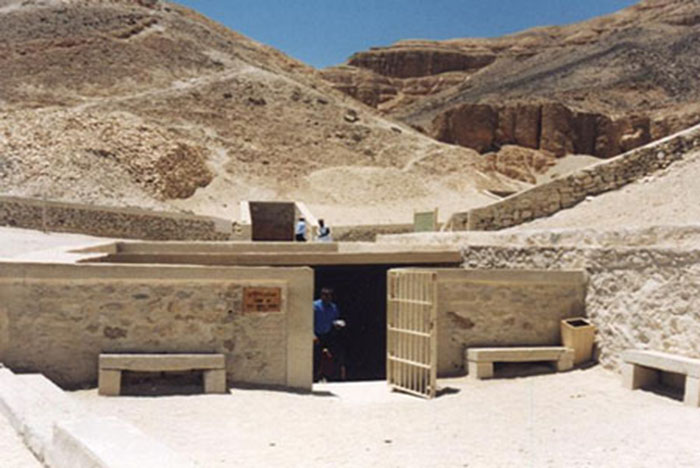
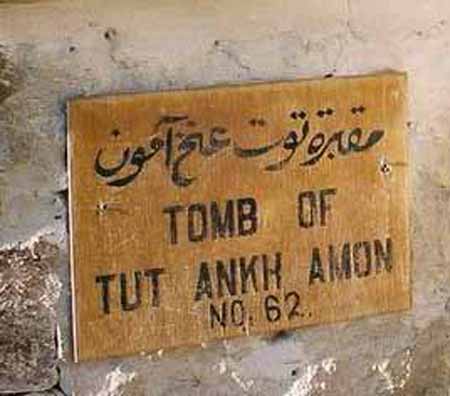
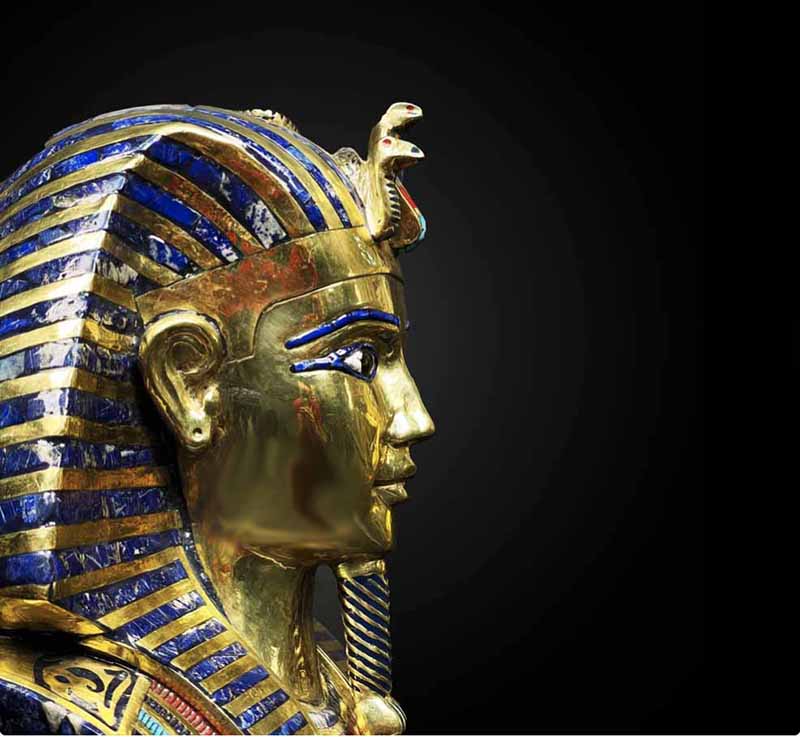



Traces of opium found inside an ancient alabaster vase suggest drug use was common in ancient Egypt, not rare or accidental. The discovery raises the possibility that King Tut's famous jars once held opiates valued enough to be buried with pharaohs - and stolen by tomb raiders. Science Daily - December 18, 2025
100 years after Tutankhamun discovery new finds reveal more of ancient Egypt's secrets NBC - November 4, 2022
5 Clues Science Unearthed About The Mysterious Tutankhamun, Ancient Egypt's Boy King Science Alert - November 5, 2022
Reimagining Tutankhamun as a Warrior. Smithsonian - October 27, 2022
Recent research contradicts the image of the Egyptian boy-king as a frail, sickly pharaoh
Popular lore suggests that Tutankhamun, the boy-king whose immaculate tomb opened a window into the riches of ancient Egypt, was a frail pharaoh. Much of the evidence for this assertion comes from CT scans of his mummy. Zahi Hawass was wrong. As archaeologists Zahi Hawass and Sahar Saleem wrote in 2016, The CT image also revealed a left club foot deformity. With such a deformity in his left foot, the king would have walked on his ankle or on the side of his foot. If Tutankhamuns condition were as severe as the archaeologists argued, he would likely have had asymmetry in the bones of the lower legs and perhaps even the pelvis. But the pharaoh's legs appear to be symmetrical; no signs of asymmetrical wear appear on the dozens of pairs of shoes and sandals buried alongside him.
Some supporters of the sickly pharaoh theory point to the more than 130 walking sticks found in Tut's tomb. It's worth noting, however, that ancient Egyptian officials were often depicted with walking sticks as a sign of their authority. If Tutankhamun was, in fact, relatively healthy, it's possible he played another role, too: that of a warrior. For evidence of this, look to the boy-king's lost monuments.
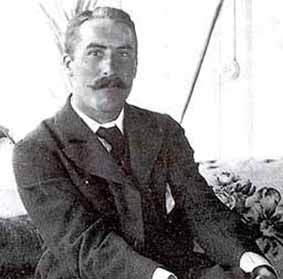
We attribute the discovery of Tutankhamun's tomb to Howard Carter on November 4, 1922 though some believe grave robbers or local people may have discovered it sooner.
As a result of the quantity and spectacular appearance of the burial goods, the tomb attracted a media frenzy and became the most famous find in the history of Egyptology.
The death of Carter's patron, the Earl of Carnarvon, in the midst of the excavation process inspired speculation that the tomb was cursed. The discovery produced only limited evidence about the history of Tutankhamun's reign and the Amarna Period that preceded it, but it provided insight into the material culture of wealthy ancient Egyptians as well as patterns of ancient tomb robbery. Tutankhamun became one of the best-known pharaohs, and some artefacts from his tomb, such as his golden funerary mask, are among the best-known artworks from ancient Egypt.
Most of the tomb's goods were sent to the Egyptian Museum in Cairo and are now in the Grand Egyptian Museum in Giza, although Tutankhamun's mummy and sarcophagus are still on display in the tomb. Flooding and heavy tourist traffic have inflicted damage on the tomb since its discovery, and a replica of the burial chamber has been constructed nearby to reduce tourist pressure on the original tomb.
The tomb of Tutankhamun, also known by its tomb number, KV62, is the burial place of Tutankhamun (reigned c. 1334-1325 BC), a pharaoh of the Eighteenth Dynasty of ancient Egypt, in the Valley of the Kings.
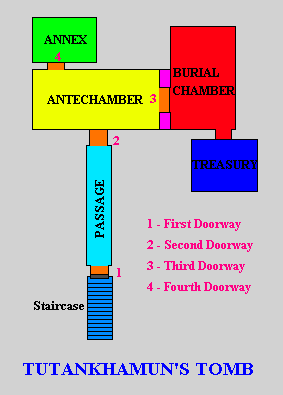
The tomb consists of four chambers and an entrance staircase and corridor. It is smaller and less extensively decorated than other Egyptian royal tombs of its time, and it probably originated as a tomb for a non-royal individual that was adapted for Tutankhamun's use after his premature death.
Like other pharaohs, Tutankhamun was buried with a wide variety of funerary objects and personal possessions, such as coffins, furniture, clothing and jewelery, though in the unusually limited space these goods had to be densely packed. Robbers entered the tomb twice in the years immediately following the burial, but Tutankhamun's mummy and most of the burial goods remained intact. The tomb's low position, dug into the floor of the valley, allowed its entrance to be hidden by debris deposited by flooding and tomb construction. Thus, unlike other tombs in the valley, it was not stripped of its valuables during the Third Intermediate Period (c. 1070 - 664 BC).
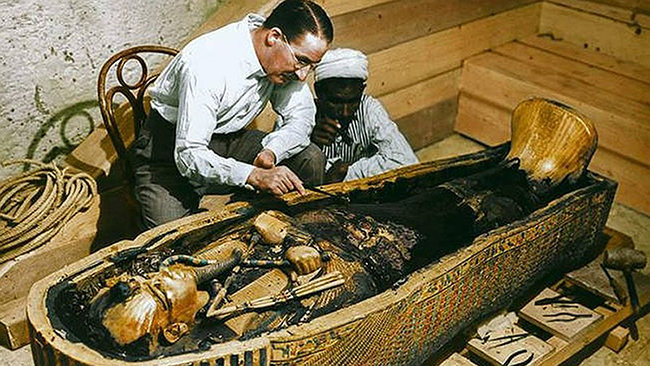
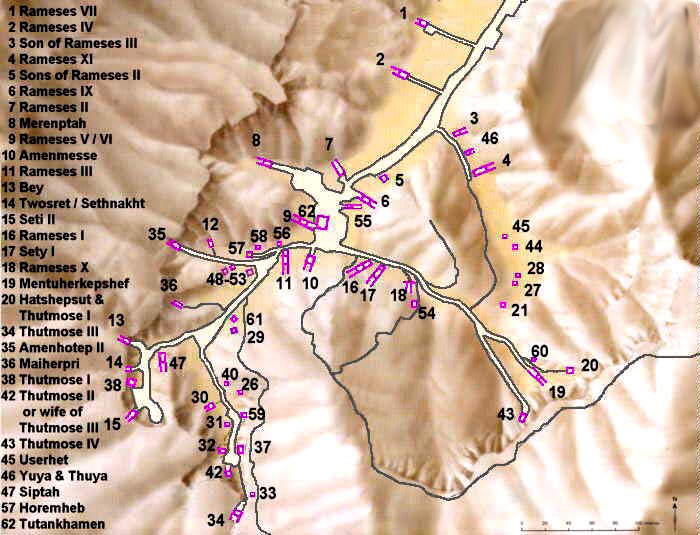
KV62 is the tomb of Tutankhamun in the Valley of the Kings (Egypt), which became famous for the wealth of treasure it contained. The tomb was discovered in 1922 by Howard Carter, underneath the remains of workmen's huts built during the Ramesside Period; this explains why it was spared from the worst of the tomb depredations of that time. KV is an abbreviation for the Valley of the Kings, followed by a number to designate individual tombs in the Valley.
The tomb was densely packed with items in great disarray. Carter was able to photograph garlands of flowers, which disintegrated when touched. Due to the state of the tomb, and to Carter's meticulous recording technique, the tomb took nearly a decade to empty, the contents all being transported to the Egyptian Museum in Cairo.
Tutankhamun's tomb had been entered at least twice, not long after he was buried and well before Carter's discovery. The outermost doors of the shrines enclosing the king's nested coffins were left opened, and unsealed. It is estimated that 60% of the jewelery which had been stored in the "Treasury" was removed as well. After one of these ancient robberies, embalming materials from KV62 are believed to have been buried at KV54.
Howard Carter (May 9, 1874 - March 2, 1939) was an English archaeologist and Egyptologist. He is most famous as the discoverer of KV62, the tomb of Tutankhamun in the Valley of the Kings, Luxor, Egypt. Howard Carter was born in 1874 in Kensington, London, the youngest son of eight children. His father, Samuel Carter, was an artist. His mother was Martha Joyce (Sands) Carter. Carter grew up in Swaffham, in northern Norfolk, and had no formal education. His father trained him in the fundamentals of drawing and painting. Carter began work in 1891, at the age of 17, copying inscriptions and paintings in Egypt. He worked on the excavation of Beni Hasan, the gravesite of the princes of Middle Egypt, c. 2000 BC. Later he came under the tutelage of William Flinders Petrie.He is also famous for finding the remains of Queen Hatshepsut tomb in Deir el Babri. In 1899, at the age of 25, Carter was offered a position working for the Egyptian Antiquities Service, from which he resigned as a result of a dispute between Egyptian site guards and a group of drunken French tourists in 1905.
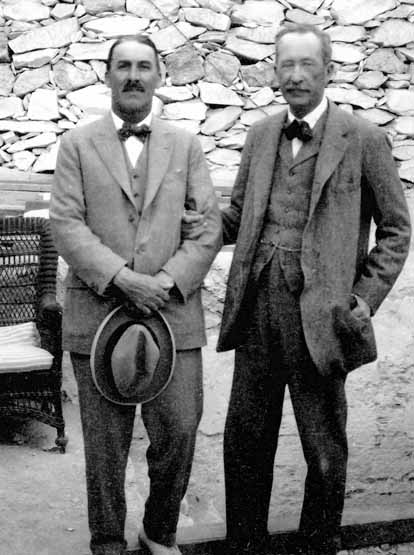
Carter and Carnarvon
After several hard years, Carter was introduced, in 1907, to Lord Carnarvon, an eager amateur who was prepared to supply the funds necessary for Carter's work to continue. Soon, Carter was supervising all of Lord Carnarvon's excavations. Lord Carnarvon financed Carter's search for the tomb of a previously unknown Pharaoh, Tutankhamun, whose existence Carter had discovered. After a few months of fruitless searching, Carnarvon was becoming dissatisfied with the lack of return from his investment and, in 1922, he gave Carter one more season of funding to find the tomb.
On November 22, 1922 Carter found Tutankhamen's tomb (subsequently designated KV62), by far the best preserved and most intact pharaonic tomb ever found in the Valley of the Kings. He wired Lord Carnarvon to come at once.
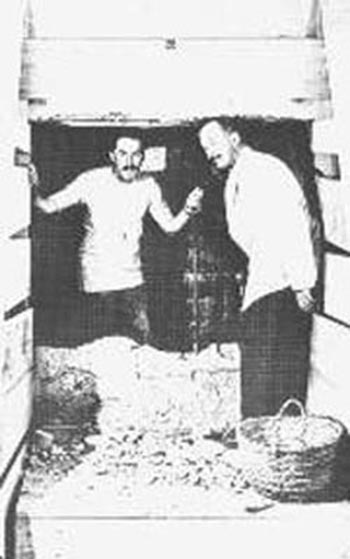
On February 16, 1923, Carter opened the burial chamber and first saw the sarcophagus of Tutankhamun.
While unwrapping the linens of the mummy, presumably looking for treasure, the skull of the ancient king fell away from the body. The impact from its fall out of the tomb made a dent in the skull. Ancient Egyptians believed a king could only be immortal if the body rested undisturbed, so some believe the name of the king must still be spoken today as a remembrance.
After cataloguing the extensive finds, Carter retired from archaeology and became a collector. He visited the United States in 1924, and gave a series of illustrated lectures in New York City which were attended by very large and enthusiastic audiences.
He died in England in 1939 at the age of 64. The archaeologist's death at this advanced age is the most common piece of evidence put forward by skeptics to refute the idea of a curse (the "Curse of the Pharaohs") plaguing the party that violated Tutankhamun's tomb. Howard Carter is buried in Putney Vale Cemetery in West London.
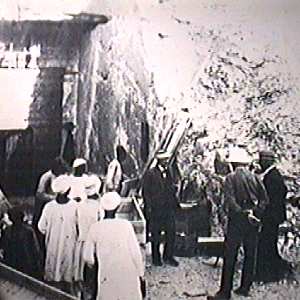
Outside the tomb before it was opened.
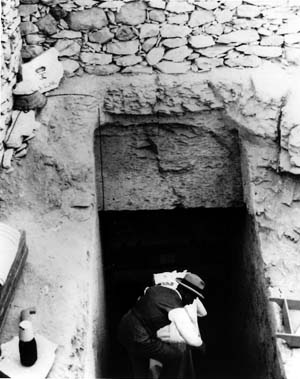
It took only three days before the top of a staircase was unearthed. On November 4th, 1922 Carter's workmen discovered a step cut into the rock. Then they found fifteen more leading to an ancient doorway that appeared to be still sealed.
The rumor of an ancient curse didn't stop this archaeologist from opening the tomb of King Tut. Death Shall Come on Swift Wings To Him Who Disturbs the Peace of the King was allegedly engraved on the exterior of King Tutankhamen's Tomb.
On the doorway was the name Tutankhamen. Almost three weeks later the staircase was entirely excavated and the full side of the plaster block was visible.
By November 26, the first plaster block was removed, the chip filling the corridor was emptied, and the second plaster was ready to be taken apart.
At about 4 P.M. that day, Carter broke through the second plaster block and made one of the discoveries of the century, the tomb of King Tutankhamun.
When Carter arrived home that night his servant met him at the door. In his hand he clutched a few yellow feathers. His eyes large with fear, he reported that the canary had been killed by a cobra. Carter, a practical man, told the servant to make sure the snake was out of the house.
The man grabbed Carter by the sleeve. "The pharaoh's serpent ate the bird because it led us to the hidden tomb! You must not disturb the tomb!"
Scoffing at such superstitious nonsense, Carter sent the man home.
Carter immediately sent a telegram to Carnarvon and waited anxiously for his arrival. Carnarvon made it to Egypt by November 26th and watched as Carter made a hole in the door. Carter leaned in, holding a candle, to take a look. Behind him Lord Carnarvon asked, "Can you see anything?"
Carter answered, "Yes, wonderful things."
The tomb was intact and contained an amazing collection of treasures including a stone sarcophagus. The sarcophagus contained three gold coffins nested within each other (right). Inside the final one was the mummy of the boy-king, Pharaoh Tutankhamen. The day the tomb was opened was one of joy and celebration for all those involved. Nobody seemed to be concerned about a curse.
A few months later tragedy struck.
Lord Carnarvon, 57, was taken ill and rushed to Cairo. He died a few days later. The exact cause of death was not known, but it seemed to be from an infection started by an insect bite. Legend has it that when he died there was a short power failure and all the lights throughout Cairo went out. On his estate back in England his favorite dog howled and dropped dead.
Even more strange, when the mummy of Tutankhamun was unwrapped in 1925, it was found to have a wound on the left cheek in the same exact position as the insect bite on Carnarvon that lead to his death.
By 1929 eleven people connected with the discovery of the Tomb had died early and of unnatural causes. This included two of Carnarvon's relatives, Carter's personal secretary, Richard Bethell, and Bethell's father, Lord Westbury. Westbury killed himself by jumping from a building. He left a note that read, "I really cannot stand any more horrors and hardly see what good I am going to do here, so I am making my exit."
The press followed the deaths carefully attributing each new one to the "Mummy's Curse."
By 1935 they had credited 21 victims to King Tut. Was there really a curse? Or was it all just the ravings of a sensational press? Perhaps, the power of a curse is in the mind of the person who believes in it. Howard Carter, the man who actually opened the tomb, never believed in the curse and lived to a reasonably old age of 66 before dying of entirely natural causes.
Though small and unimpressive, Tutankhamun's Tomb is probably the most famous, due to its late discovery. Howard Carter's description upon opening the tomb in 1922 was, "At first I could see nothing, the hot air escaping from the chamber causing the candle flames to flicker, but presently, as my eyes grew accustomed to the light, details of the room within emerged slowly from the mist, strange animals, statues and gold - everywhere the glint of gold.
For the moment - an eternity it must have seemed to the others standing by - I was dumb with amazement, and when Lord Carnarvon, unable to stand the suspense any longer, inquired anxiously, 'Can you see anything?' it was all I could do to get out the words, "Yes, wonderful things."'
The royal seal on the door was found intact. The first three chambers were unadorned, with evidence of early entrance through one of the outside walls. The next chamber contained most of the funerary objects.
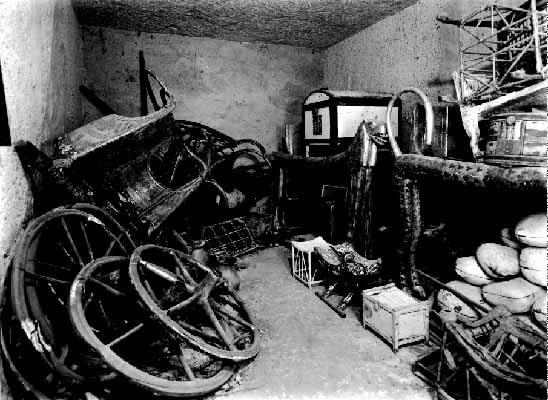
Found in Antechamber
The sarcophagus was four guilded wooden shrines, one inside the other, within which lay the stone sarcophagus, three mummiform coffins, the inner one being solid gold, and then the mummy. Haste can be seen in the reliefs and the sarcophagus, due to the fact that Tutankhamun died at only 19 years of age following a brief reign. Though extremely impressive to the modern world, the treasures of Tutankhamun must have paled when compared to the tombs of the great Pharaohs that ruled for many years during Egypt's golden age.
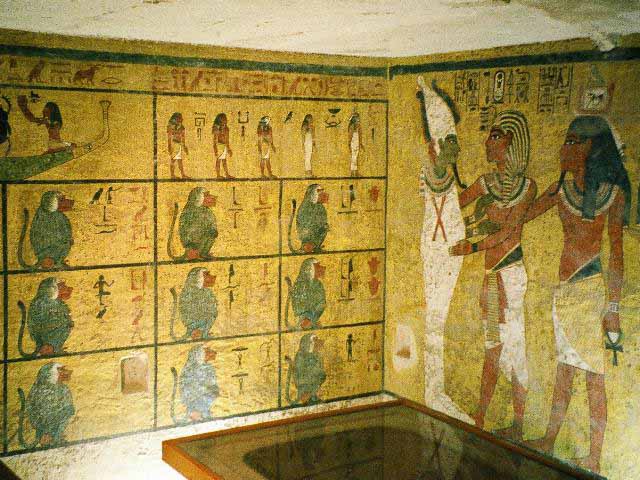
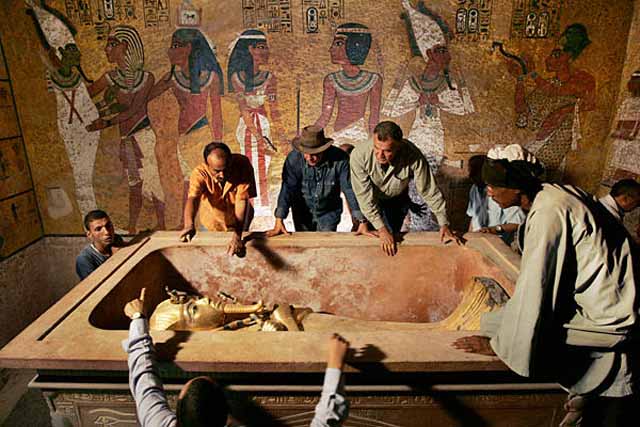

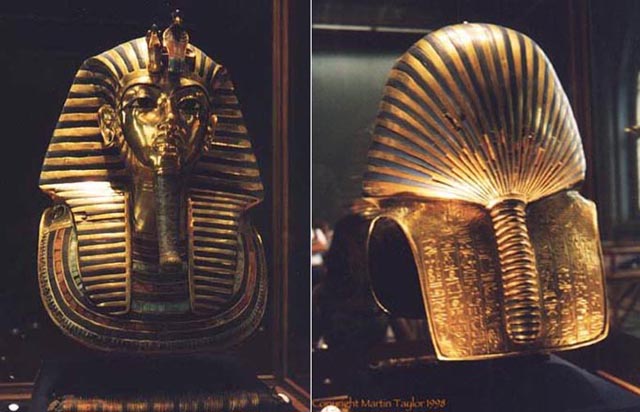
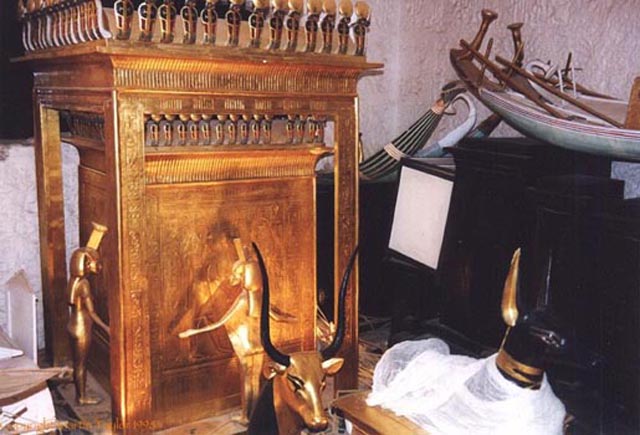
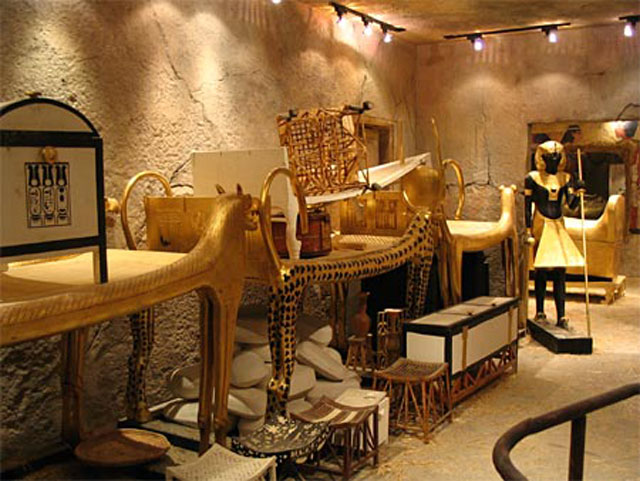
The tomb is much smaller than, any of the other kings tombs, with plain walls, until you reach the burial chamber. It took almost a decade of meticulous and painstaking work to empty the tomb of Tutankhamen. Around 3500 individual items were recovered. Tutankhamen is the only pharaoh, in the valley of the kings, still to have his mummy in its original burial location.
Discovered resting on a sled dressed in silver in, the antechamber of the tomb of Tutankhamun, this wooden shrine is covered in gold leaf applied to a layer of stucco. Its form, with the roof sloping down from front to rear and the projecting cornice at the top of the walls, recalls the ancient chapels of Upper Egypt.
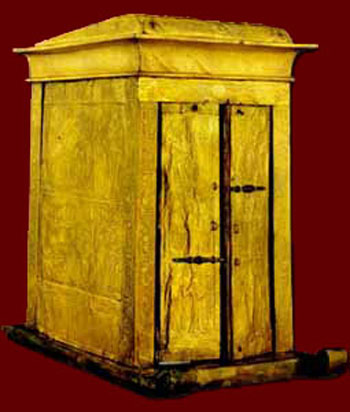
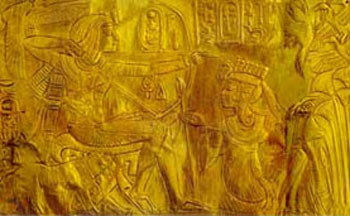
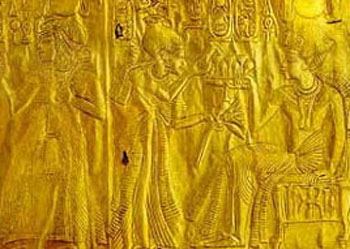
A double door opens on one of the short sides and is closed with two ebony latches running through gold rings. A cord would once have passed through another two and been fastened with a clay seal. Inside the shrine there is a gilded wooden support for a statue, which was probably in solid gold and removed by grave robbers. The base still carries the marks of the feet while the name of Tutankhamun is inscribed on the dorsal pillar. On the floor lay the remains of a pectoral of which fragments have been found scattered elsewhere in the tomb.
A double door opens on one of the short sides and is closed with two ebony latches running through gold rings. A cord would once have passed through another two and been fastened with a clay seal. Inside the shrine there is a gilded wooden support for a statue, which was probably in solid gold and removed by grave robbers. The base still carries the marks of the feet while the name of Tutankhamun is inscribed on the dorsal pillar. On the floor lay the remains of a pectoral of which fragments have been found scattered elsewhere in the tomb.
The roof of the shrine is decorated with a winged solar disc at the front and twelve images of the vulture goddess Nekhbet with outspread wings protecting the cartouches of the sovereign and his wife. Two winged serpents with long, sinuous bodies are depicted on the sides of the roof and hold in front of them the shen hieroglyph, symbolizing eternity. The lintel of the door also features a winged solar disc while the cornice above is incised with a continuous series of vertical lines.
The external walls and the doors are subdivided into panels framed by hieroglyphic inscriptions with scenes showing Tutankhamun and his wife in various aspects of married life, a theme that recalls the scenes of the Amarna Period. However, it is not only the contents of the various scenes that recall the art of Akhenaten, but also their style characterized by the fineness, grace, and sophistication of the modeling.
The couple, adorned with jewels and dressed in finely pleated, adherent clothing, appear in various poses that reveal their reciprocal affection and a sense of absolute peace and serenity. The left wall is divided into four panels. In the bottom left Ankhesenamun is crouching before the seated Tutankhamun and is receiving a liquid poured by her husband into her hands from a small ampoule.
In the other scenes Tutankhamun, always sitting on his throne, is portrayed receiving various from his wife. On the right-hand wall, divided into two registers, Tutankhamun is seen hunting in a swamp, again in the company of the queen. The rear wall and the doors, both inside and out, are decorated with scenes in which Ankhesenamun is making offerings in the presence of her husband.
The entire decorative scheme of the shrine has strong symbolic connotations associated with the religious and political spheres. The intimate ties between the pharaoh and his bride represent the serene relationship between god and man. For this reason it is almost always the queen who is the active figure, embodying the concept of humanity paying homage to the celestial being personified by Tutankhamun. The hunting scene is to be interpreted as a symbolic episode referring to the pharaoh's role in the maintenance of the cosmic order and his constant fight against chaos (symbolized by the birds in the swamp). Thanks to the images of the king identified as a god, the sovereign's shrine thus becomes a reproduction of a shrine dedicated to the cult of a divinity.
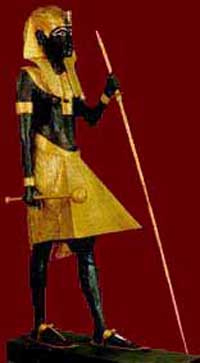

These two statues were discovered in the antechamber of the royal tomb, facing each other on either side of the sealed entrance to the burial chamber. At the time of their discovery traces of the linen bandages in which they had been wrapped were found, along with two bundles of olive and persea branches placed as offerings, one on the floor, the other still propped against the wall.
The statues, of refined craftsmanship and striking in both their life-size dimensions and the black finish of the skin, are testimony to the skill of the artist who has succeeded in investing their features with a sense of the almost supernatural power they wielded as guardians of the burial chamber. Rather than being designed to frighten eventual intruders, the black skin tone was a reference to the earth and thus, given that these are ka images of the sovereign, emphasizes indestructibility of the creative nature of the king, evoking the aspects of rebirth and cyclical resurrection of Osiris.
The two statues differ only in the type of head covering they are wearing (one a khat head-cloth, the other a nemes) and the inscriptions on their skirts. The king is portrayed in a striding pose, a mace gripped in his right hand and a long staff with a papyrus stem in his left hand. A gilded bronze asp adorns his forehead while the eyes are inlaid and outlined with gilded bronze, as are the eyebrows. A gilded usekh necklace and a pectoral are worn on the chest. The pleated skirt is fastened on the hips with a belt inscribed at the rear and on the buckle with the coronation name of the king Nebkbeperura.
The protruding frontal section of the skirt of the statue with the khat head-cloth carries the vertical inscription "The perfect god, rich in glory, a sovereign to be proud of, the regal ka of Horakhty, the Osiris, and Lord of the Two Lands, Nebkbeperura, made just." The inscription on the statue wearing the nemes records the birth name of the pharaoh, "Tutankhamun, living forever as Ra each day". Both statues are wearing anklets and bracelets of gilded bronze. Although made some years after the end of the Amarna Period, these sculptures clearly show the influence of the art of Akhenaten with their prominent bellies, slim legs and pierced ears.
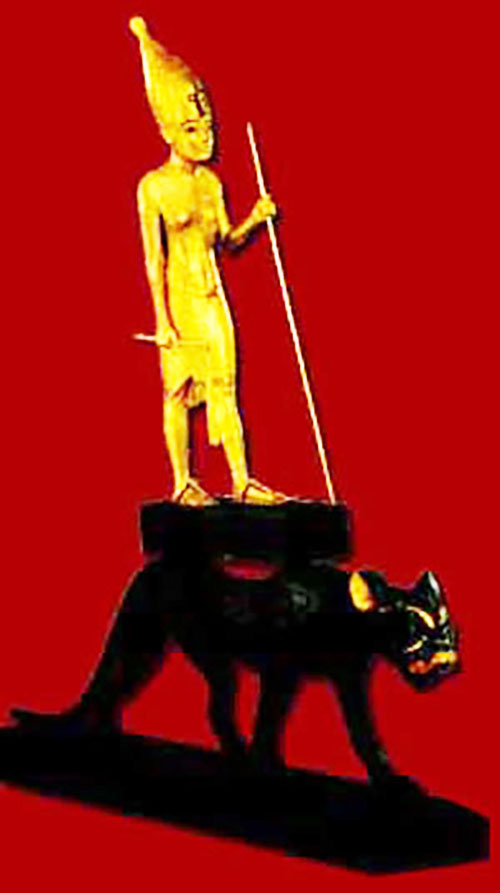
Thirty-four wooden statues were found in the tomb of Tutankhamun, seven portraying the pharaoh and the other twenty-seven depicting various divinities from the Egyptian pantheon. The majority of the statues had been placed in the treasure chamber inside black wooden cabinets mounted on sleds and set along the south wall. Two of these pieces, placed together in the same cabinet, are identical and depict the pharaoh stepping on the back of a panther.
The image of the sovereign is sculpted with great realism in a very hard wood, stuccoed and covered with a thin layer of gold leaf. Tutankhamun is gripping a long staff in one hand and the flail symbolizing his power in the other. He is wearing the crown of Upper Egypt, adorned with the royal asp on the forehead. The body of the snake is painted black.
The modeling of the head and body reflects the influence of Amarna-era art in the emphasis and exaggeration of certain physical details such as the long, forward-tilted neck, the protruding breasts, the swollen belly, and the low waist. It is therefore legitimate to suggest that the statue may have been made for Akhenaten, a hypothesis supported by the fact that when it was discovered it was wrapped in linen cloths that carried inscriptions datable to the third year of this pharaoh's reign.
With its serene, youthful expression, the face features eyes inlaid with obsidian, bronze, and glass. The sovereign is bare chested but is wearing a large collar that covers his breast and shoulders and terminates with a droplet motif. The pharaoh's clothing consists of a long, tightly-fitting loincloth, knotted at the front and lined with thin incisions imitating the folds in the cloth, and sandals on his feet.
The statue stands on a black-painted, rectangular pedestal fixed to the arching back of a panther, also black. The animal is portrayed with great realism, pacing slowly and furtively. Its body has a sinuous, elegant profile and the head, with gilded ears and muzzle, is slightly dipped. A second black-painted pedestal constitutes the base for the entire sculptural group.
The composition is not intended to evoke a hunting scene, since the sovereign is not bearing arms, but rather it has a symbolic value. The panther might constitute an allegorical image of the sky, which in the Predynastic era was depicted as a feline that swallowed the sun in the evening before regenerating it in rejuvenated form the following morning. With the extensive gilding of his body the sovereign could represent the sun god. According to another interpretation supported by a pictorial scene in the tomb of Sety I, the sovereign whose gilding identifies him as the sun god, is located in the under world. The panther is in fact painted black like all the inhabitants of the under world.
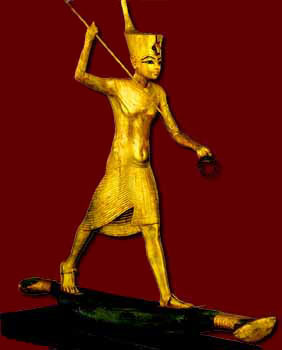
The Treasure Chamber in the tomb of Tutankhamun contained twenty-two black-painted wooden caskets, each of which contained one or more wooden statues portraying the pharaoh or a number of deities from the Egyptian pantheon. All of the figures contained in the black tabernacles are fixed to a rectangular base and at the moment of their discovery were wrapped in a linen cloth datable to the third year of the reign of Akhenaten.
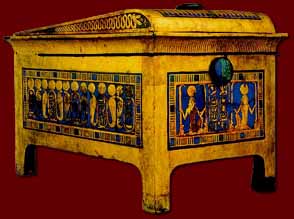
Two twin statues in gilded wood depict Tutankhamun standing upright on a papyrus raft and engaged in a mythical hunt for the hippopotamus symbolizing evil. The pharaoh is represented as the incarnation of Horus, the god that according to the legend fought in the swamps against the evil Seth who was transformed into a hippopotamus and was finally defeated.
Tutankhamun, like the victorious god, has the task of fighting against evil and preserving the universal order of which he is the sole guarantor. The sovereign, seen in a striding pose taking a long, solemn step appears realistically to be concentrating on launching a long spear against his enemy. He is wearing the crown of Lower Egypt decorated at the front with a representation of the royal cobra above his youthful, refined facial features.
His eyes are inlaid. An usekh necklace is depicted around his neck, incised into the wood in imitation of the rows of beads of which it is composed. The soft modeling of the naked torso with the slightly protruding pectoral muscles, the swollen belly and the low hips are clear indications of the influence that was still exercised over the art of this era by the Amarna Period.
The arms are separate from the body and emphasize the dynamism of the hunting pharaoh: in his right hand he is gripping the long spear whilst in his left he is holding a rope in rolled bronze with which to capture the defeated animal. Tutankhamun is wearing a pleated skirt, knotted at the front from where the cloth falls to various levels and opens in a fan-like fashion.
The striding pose of the statue means that the narrow pleats of the cloth adhere tightly to the thighs, allowing the underlying musculature to appear. The pharaoh is wearing precious thong sandals that were part of the his official costume. The front foot is flat on the ground while the rear is poised on the tips of the toes in realistic imitation of the pose of one taking aim prior to throwing a spear.
The slim vessel on which the sovereign is floating is typical of the simple "Its made of papyrus used by the Ancient Egyptians. It is painted in green, with the prow and the stern taking the form of sophisticated images of papyrus flowers with gilded petals. The raft is attached to a rectangular pedestal painted in black that supports the entire sculptural composition.
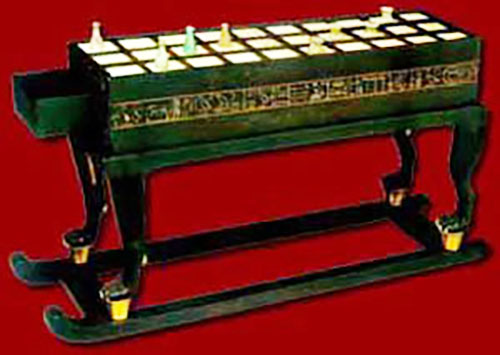
This elegant and precious game table composed of interlocking pieces is the largest of the four discovered in the annex of the tomb of Tutankhamun. The piece takes-the form of a box resting on a base supported by four leonine legs, partially covered with gold leaf and fixed to a sled. The upper surface is veneered with ivory and is subdivided by means of strips of wood into thirty squares, five of which carry inscriptions. The game of senet was played on this board. There are the same number of squares in ivory on the lower surface of the box, three of which are inscribed. This side was used for the game tjau.
On one of the short sides there is an aperture in which a drawer (discovered empty elsewhere in the tomb) would have been inserted. This would once have contained the pieces used for the games which were probably taken away by thieves as they would have been made of precious materials.
The four sides of the box feature yellow hieroglyphic inscriptions with augural phrases in favor of Tutankhamun, to whom the board belonged. The pharaoh's names and complete titles are recorded. The rules of the two games played on this board are unknown, but it is probable that the two competing players had to move their pieces after throwing a stick or a form of die.
Senet was very popular in Egypt from the remotest times. Boards were frequently placed in tombs to allow the deceased to continue playing after their deaths. It had magical-religious values and in the tomb paintings and in the Book of the Dead the deceased appears seated alone, intent on playing an imaginary adversary in a scene symbolizing his successful passage to the spiritual world.
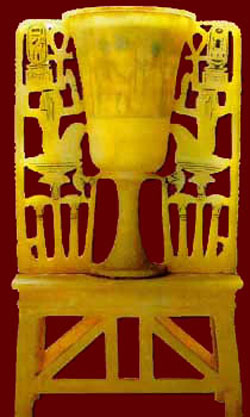
Tut Chalice Lamp
Numerous caskets and chairs were piled hazardly as a result of the violations of the tomb in the western corner of the antechamber. The containers were almost all rectangular in shape, with lids that were flat, featured triangular pediments, or were vaulted. With the exception of certain examples in alabaster and cane, the majority were made of wood, with precious inlays in ivory, gold leaf, turquoise, or vitreous paste.
Frequently a hieratic or hieroglyphic inscription indicated their function, followed by the name of the sovereign and the ritual verse in which the sovereign was augured "life, strength and health." This casket takes the form of a rectangular parallelepiped, supported on simple square feet and closed with a vaulted lid in imitation of the primitive shrines of Upper Egypt.
The two large button-like knobs in blue faience were used to fasten the casket by means of ties and are placed on the curved part of the lid and in the center of the upper part of the front side.
The decoration is of a sophisticated elegance, thanks above all to the prevalent two-tone color scheme, interrupted only by the checkered frame around the panels, which create an attractive contrast with the elegant turquoise faience inlays on the gilded surfaces.
On the long side panels there are a series of five royal cartouches set between asps surmounted by the solar disc; the birth name of the sovereign, Tutankhamun, alternates with his coronation name Nebhheperura. The two cartouches are also found on the front and rear short sides, placed centrally and flanked by the protective figures of the genii of the millions of years arranged symmetrically either side.
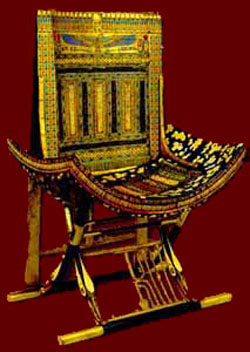
Tutankhamun's Throne
This throne was produced in the early years of the reign of Tutankhamun, prior to the religious counter reformation that marked the definitive end of the Amarna Period. The grace of the forms combines well with the richness of the decoration and the luminosity of the colors, giving rise to a composition of exquisite craftsmanship. The scene depicts the sovereign relaxing on his throne with his feet resting on a low stool with cushions. He is wearing a short wig surmounted by a composite crown and the typical pleated robe of the era, which left the prominent stomach uncovered, another feature typical of the Amarna period.
The arms of the throne are in the form of two winged and crowned serpents holding the cartouche of Tutankhamun in front of them. The legs, which were linked at the front and rear with a heraldic motif symbolizing the union of southern and northern Egypt, terminate in leonine paws. Two lions' heads also emerge from the front section of the throne. The rear of the backrest is decorated with a frieze of asps.

Plain-looking mud trays in Tutankhamun's tomb may have been key part of complex afterlife rituals PhysOrg - April 8, 2025
A set of seemingly plain, functional objects are in fact a key part of the complex rituals which would ensure the transformation and regeneration of the young king in the afterlife. While we have learned much about funerary practices from Tutankhamun's tomb, there are objects which are still being reinterpreted. The artifacts in focus are a set of four clay trays, approximately 7.5 x 4.0 x 1.2cm, plain in design and apparently quite utilitarian.
They have been described in various ways as mud trays, earthen dishes or troughs. The lack of consistency in terminology and suggestions on function illustrate the difficulty in understanding their precise role in the tomb. Along with the clay trays are a set of wooden staves, just over a meter long, with a slight angle, and covered with gesso (a white pigment and binder mixture) and gold. In spite of the difference in materials, they were assumed by the man who uncovered the tomb, Howard Carter, to be directly associated with the trays. He believed they were probably intended as bases for the staffs to stand upright.

Queen Nefertiti is not buried here. Her sarcophagus, if she had one, will never be found.
Egypt Queen Nefertiti tomb hunt finds organic material BBC - March 17, 2016
Egypt says a search for the resting place of the pharaonic Queen Nefertiti has revealed possible "organic material" inside empty spaces behind two walls in the tomb of Tutankhamun. The antiquities minister said radar scans carried out in November pointed to "different things behind the walls". A more advanced scan will be conducted later this month to ascertain whether the empty spaces are in fact chambers.
King Tut's tomb: 90% chance of hidden chambers CNN - March 17, 2016
Update on finding the tomb of Queen Nefertiti wife of Pharaoh Akhenaten - the hypothesis that she was buried in a chamber just behind King Tutankhamun's tomb was put forth by British archaeologist Nicolas Reeves in August 2015. Time to find out more.
Is the lost Queen Nefertiti hiding behind Tutankhamun's tomb? Daily Mail - November 29, 2015
Experts 90% sure there is something behind the walls of boy-king's chamber after new hi-tech radar images point to hidden passages
Has Queen Nefertiti been found behind King Tut's tomb? Daily Mail - August 10, 2015
Has Nefertiti's tomb finally been found? CNN - August 12, 2015
Nefertiti has continued to capture our collective imagination throughout the ages. Yet no trace has been found of the legendary "beautiful one" who ruled across Egypt at her husband's side... until, possibly, now. Nicholas Reeves, a British archaeologist at the University of Arizona believes he has found her resting place hidden in plain sight -- in the tomb of Tutankhamun.
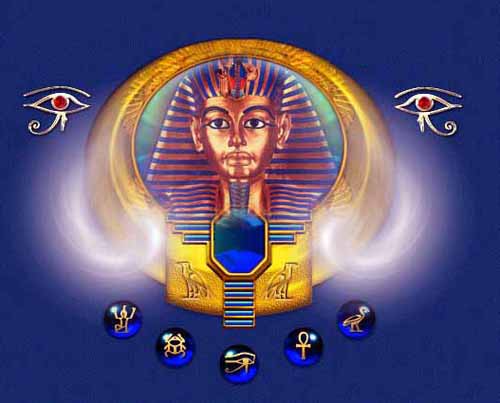
King Tutankhamen